What Is Timbre? Defining Color in Music and Why it Important

Have you ever wondered why people sound different when they sing the same tunes? Or why a violin and piano sound so totally distinct even when playing the exact same piece or composition?
The answer is something called “timbre”, which is the sonic profile of an instrument’s sound. Timbre is also called tone “quality” or “color”, and helps us to define sound. Timbres are unique to each instrument. So simply put, timbre is what helps us tell different instruments apart.
What Is Timbre in Music?
Timbre is certainly associated with the study of music, but it’s hard to quantify. It isn’t quite music theory, as much as soundcraft. Timbre goes above and beyond written music or hard and fast theory and opens up our imaginations. This is going to be fun…
Modern musicians are more acutely aware of timbre and how to reproduce certain sounds with their instruments or software than they even know.
Knowing which instruments to use in an arrangement, which plug-ins or softsynth patches to select while producing, and even how to physically play your instrument to produce various sounds is a daily part of being a creative.
Learning about timbre is like learning about how to use different spices as a chef, to craft the perfect dish.
Here is everything you need to know about timbre and how to harness its creative power in your music making.
What are Overtones?
Without diving too deeply into the math-y side of music theory, overtones are pitches above the fundamental pitch we play or sing. These pitches are called “harmonics”.

Whenever we play or sing a pitch a sound wave is created. These sound waves contain both the “fundamental” tone we’ve played or sung, in addition to other higher pitches called “harmonics”.
Harmonics are usually too faint to be wholly distinguished by the naked ear, but heavily influence the overall sound quality (timbre) of an instrument, including the human voice. This is why the same note played on different instruments can sound so wildly different.
The materials that an instrument is made from, whether it is bowed, plucked, struck, or blown, and even the size and shape of the instrument can produce different harmonic overtones, creating a unique soundwave that we recognize as various and distinct instruments.
Soundwaves are made up of two elements: the “spectrum” which is the frequency, and “envelope” (shape). Waves can be simple or complex. Simple waves contain less overtones and more of the fundamental pitch, while complex waves contain many strong overtones. An example of an instrument with a more simple timbre is the oboe, which produces a strong fundamental tone.
The clarinet is somewhere in between, particularly emphasizing harmonics over the fundamental to create their unique timbre.
Crash cymbals, like those found on a drum kit or in an orchestra, on the other hand are so rich in overtones that a fundamental pitch is almost totally indistinguishable. These types of instruments aren’t “pitched” or “tuned” like the aforementioned.
But how do we know all this? And how on earth can we harness and understand these seemingly celestial sounds? Overtones are expressed in “Hertz”, the globally recognized unit of measurement used for the sound spectrum.
Human beings can hear in a range between 20 Hz and 20,000 kHz (kilohertz). Although this range diminishes overtime, with most adults with healthy hearing able to perceive up to 16,000 kHz.
When we play or sing a pitch, a fundamental frequency is produced as a soundwave. Overtones are multiples of whatever that frequency is that we are playing. For example, the note “A4” has a frequency of 440 Hz. When we play A4, harmonics are produced at 880, 1760, 3520 and so on.

(If your math is as wonky as mine, the number doubles each time… *wink*).
Which harmonics are present in the sound wave, and how strong each harmonic is changes the characteristics of the soundwave, thus creating timbre!
You can actually see this in action by using a graphic EQ, commonly found in most DAWs (digital audio workstation) on a computer.
First, let’s look at a sine wave of A4 at 440 Hz.
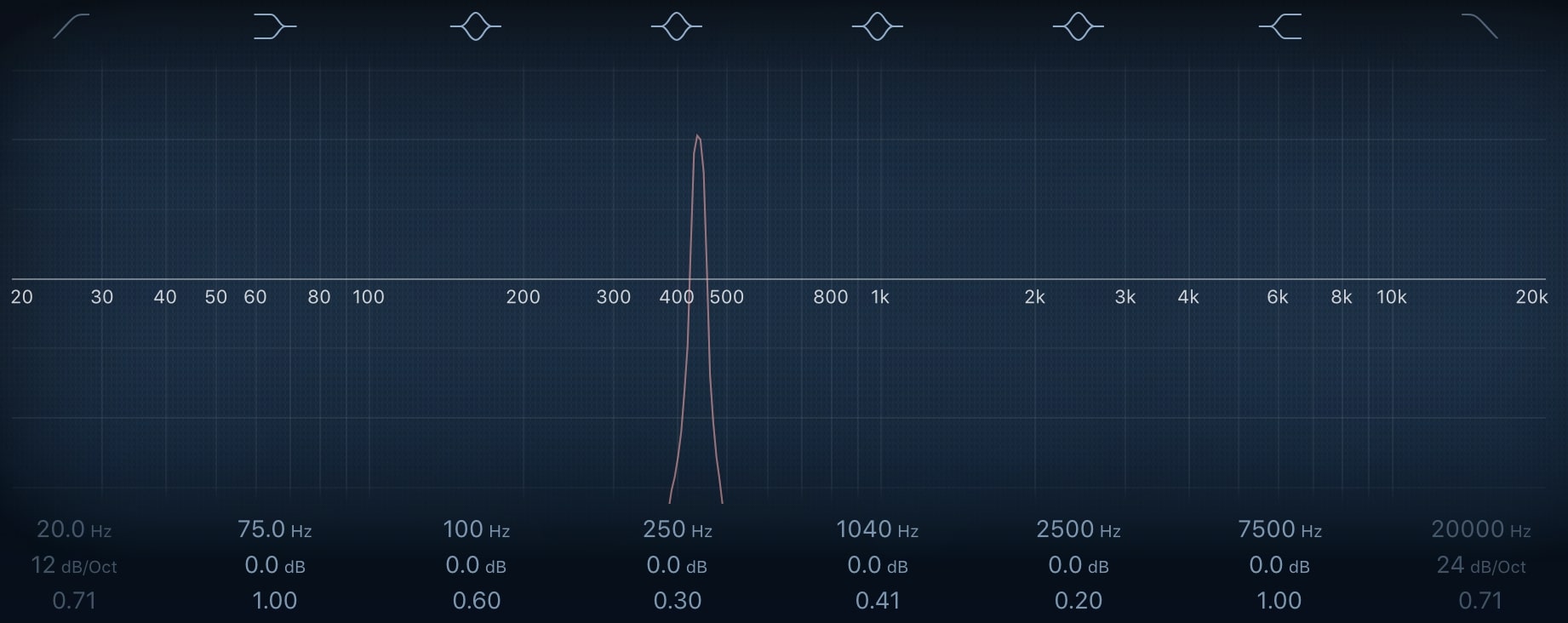
You can see the overtones as spikes along the soundwave at 880, 1760 and so on…
Here is the same pitch on violin.
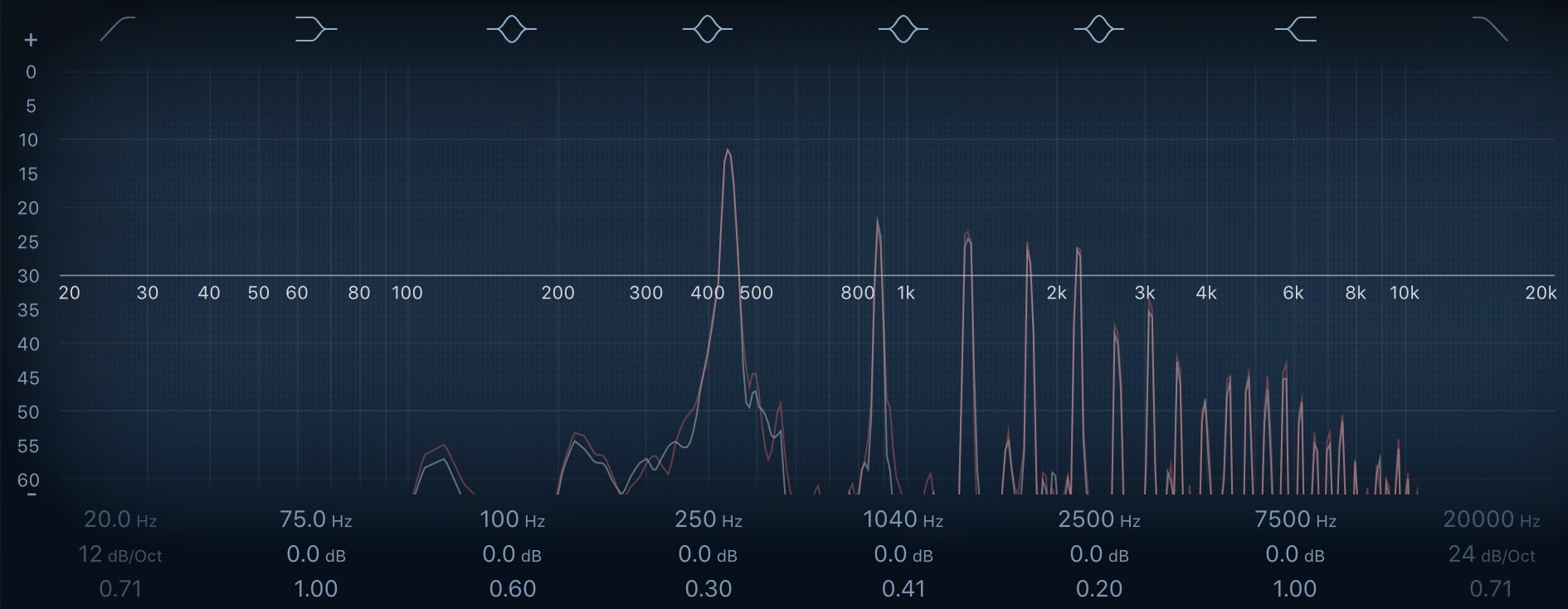
See how rich the harmonics are on the violin? These incredibly pronounced overtones give the violin its distinct bark and nasally quality.
And finally on an oboe.
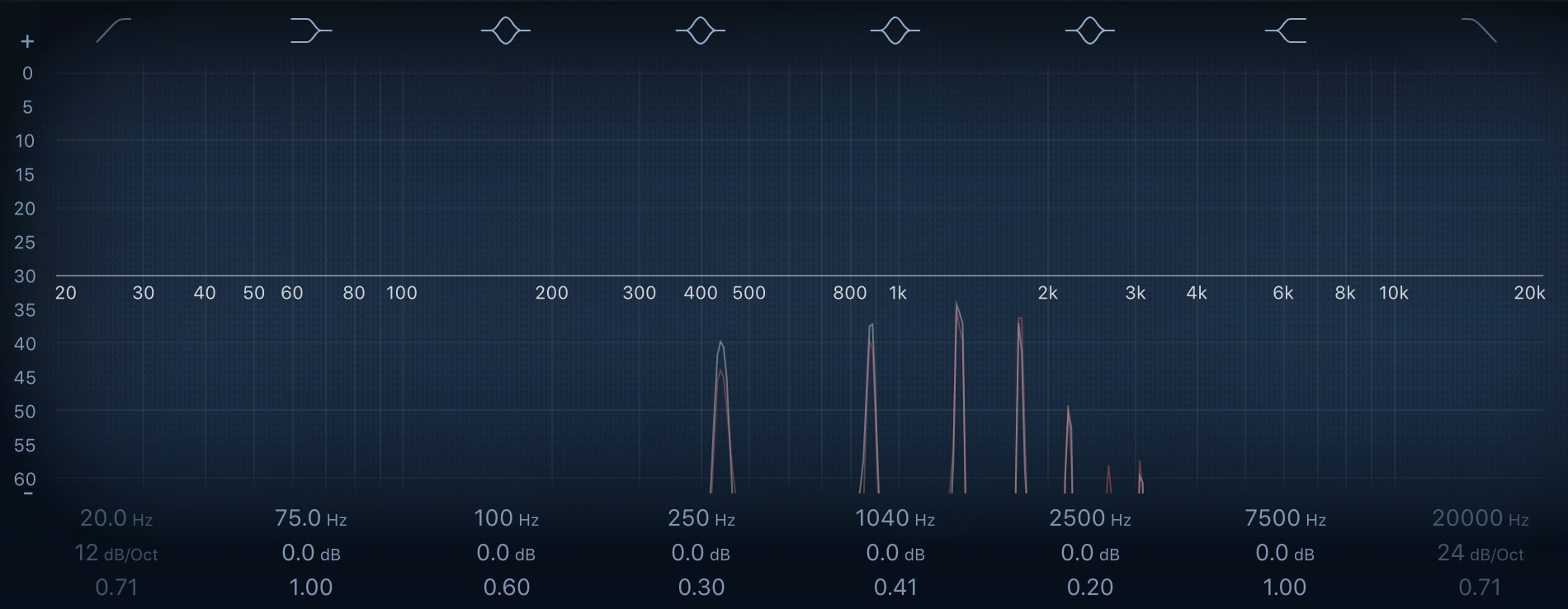
See how the frequency spectrum changes based on which instrument is playing the note? Pitches with very present harmonics sound richer and more complex, while less harmonics puts more emphasis on the fundamental pitch.
Even though the harmonics are multiples of the fundamental pitch, they aren’t always the same note!

The “overtone series”, also called the “harmonic series” is a graph that maps the possible overtones produced by a fundamental pitch.
The fundamental pitch of F3 for instance, produces overtones at F4, C5, F5, A5.
Okay so hold on… I know what you’re thinking. F, A, and C? Wouldn’t all those different notes played together just sound like a harmony, or an F major chord?
Good eyes (and ears). The difference between harmony and harmonics is that harmonics are incredibly faint. They aren’t present enough to trick us into hearing the additional notes as their own wholly integrated sounds.
However, the harmonic series is in fact how we developed our system of organizing musical pitches into chords. That deserves another article, but for now let’s move on to part two…
Fun Fact: Many cellular phone speakers have a range of 200 Hz - 12,000 kHz. So when you’re mixing your next smash with tons of low and high-end frequencies, most people may never hear them!
How Sonic Envelope Affects the Timbre of an Instrument
The second element that creates timbre is the sonic “envelope”. Envelope refers to the amplitude (loudness) of a note over a period of time. The parameters we use to control envelopes are Attack, Decay, Sustain, and Release, often abbreviated as “ADSR”.

You’ve likely seen these controls available to tweak on a software synthesizer.
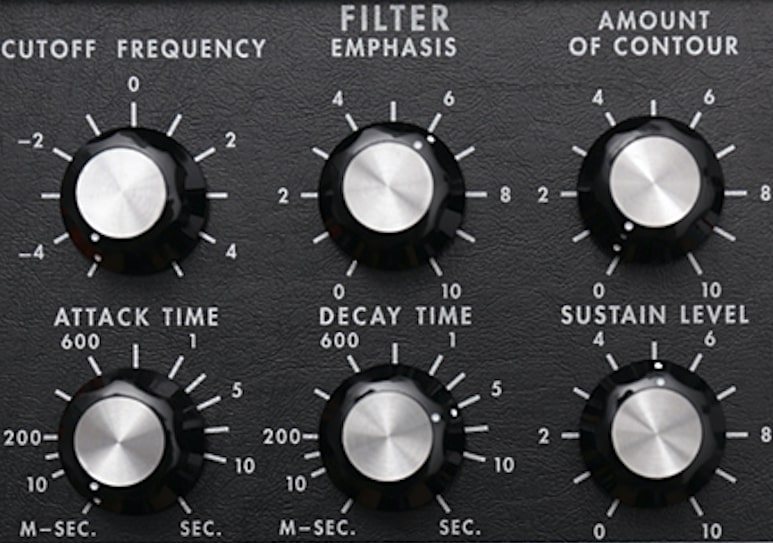
Decay is the length of time it takes for the note to come down in volume until it reaches a steady amplitude, called sustain.
Fast decay means the note will quickly drop off from its peak to the lower sustained volume level. Slow decay means it will gradually decrease in volume until it reaches a sustain point.
Finally, release is the length of time the note continues “ringing” out after the musician stops playing it.
For example, if a pianist uses a sustain pedal, and releases the piano key, the sound will continue even after the pianist has stopped pressing on the piano key.
Some instruments can produce multiple envelopes, creating changes in timbre on the same instrument.
For example, stringed instruments can be bowed, plucked, or even tapped with the reverse side of the bow. These techniques change the ADSR, as well as the intensity of the different harmonics, resulting in new sounds. We’ll talk a bit more about this in the next section.
Noise
One last thing worth mentioning is noise. “Noise” comes in several forms, most commonly “white” and “pink” noise. Noise is unpitched, and so harmonically dense that it has no discernable pitch or series of overtones. Things like cymbals and extremely distorted sounds can have this quality.
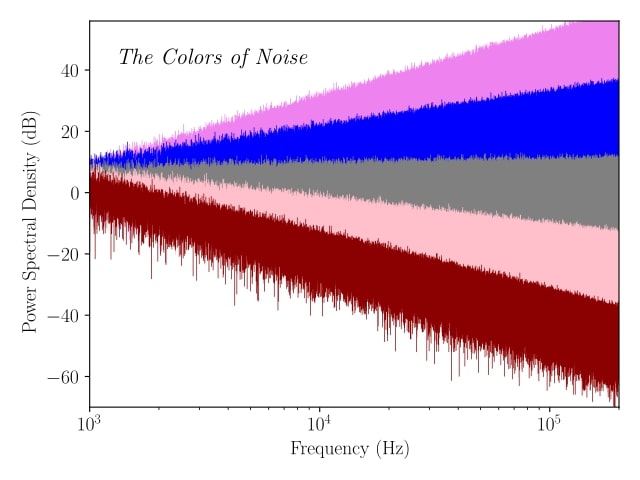
Noise can also be integrated into other sounds, shifting that sound’s timbre. Guitar for example is especially known for this, with signal processing often being applied to alter the instrument’s sound.
How to Describe Timbre in Music?
Describing different timbres is an inexact science, and can often be subjective. Musicians have, however, settled on various terms to describe different sounds.
Many timbres are described by comparing them to other real world things and sounds, like animals, cars, or the weather!
Many of these sounds are also onomatopoeias, or just plain nonsense.
Beginning with the basics, many timbres are classified as “light” or “dark”.
Instruments with a heavy, dark timbre, rich in bass or lower-midrange harmonics are often called “boomy” or “guttural”.
Lighter timbres are associated with instruments with a lot of high mid-range or treble harmonics. Words like “brilliant” (think diamonds) or “shimmery”.
A complex sound with many harmonics could be labeled as “rich”, “thick”, “syrupy”, “saturated”, or “lush”.
For aggressive sounding instruments with a lot of powerful mid-range like distorted guitar, terms like “bark”, “nasal”, “growling”, and “beefy” suffice.
For especially high-pitched instruments, like piccolo, the violin, or a coloratura soprano adjectives like “shrill” or “soaring” could be used.
Sounds that have an ultra fast attack with minimal sustain or release can be described as “snappy” or “crack”. If an instrument has a fast attack with lots of mid-range overtones, it can be called “punchy”.
If a sound lacks low-end or mid-range, it can sometimes be called “thin”, “tinny”, or “whiney”.
Techniques like “vibrato” or “tremolo” can also contribute to timbre and are eponymous. These techniques can be applied by the instrumentalist to alter an instrument's timbre a la carte. Meaning that the instrument doesn’t need to inherently have the quality of oscillation. Bowed instrument players for example can rapidly shake their bows to produce the tremolo effect, while keyboard players or guitarists might use a rotary effect or Leslie speaker to create this timbre with their instrument.
This term is used when referring to vocals, as well as “breathy” (timbre including un-pitched breath sound) and “airy”, referring to a sound with a ton of top-end at the threshold of human hearing.
Many of these terms come up most often when referencing drum sounds.
If you’ve ever used a royalty-free sample library like Splice.com or LANDR, you’ve probably seen one-shot drum samples labeled with terms like “kick_morepunch”, “boomy_kick”, “clicky_kick”, or “fast_snare”, “snare_thwack” or “ringy_snare”.

These are all great examples of timbre in action, as part of our everyday interaction with music and its peripherals, and a wonderful reminder of why this is an important musical skill to develop.
These terms evolve overtime, with many being used by producers and composers to describe the sound of various instruments and their respective timbres. Feel free to express yourself in your own way when it comes to describing sounds, although it’s always useful to pay attention to how others describe timbre. This can be useful when you’re collaborating with other musicians and need to communicate ideas for different sounds or parts clearly.
Why Timbre is Important in Music
Music is a lot more than notes, scales, beats, and chords. By cultivating our understanding and implementation of timbre we open up a unique creative side of composing, performing, and producing.
Think of music as a painting, with different instruments acting as different colors that blend together into one final work.
The blend of different colors results in the final composition. By learning how to utilize various timbres in our music making, we lift the music from the page, score, or MIDI editor and bring it to life.
Timbre is a critical element in every stage of the writing and production process, from the initial tone of the piece, to the instrumentation, orchestration, mixing, editing, and mastering. Practitioners in all of these disparate musical fields work with tone quality and sound each step of the way, to create a final masterpiece that makes your ears go “Ahh!”.
Music is truly an exploration of sound and how it relates to our human experience. Timbre is a second-level way of bringing music to life off and outside of the page, and an invaluable tool in every musician’s kit.
We hope this article has inspired you to get creating and see (or hear!) music a little differently. Keep playing, composing, and practicing, and don’t forget to keep those ears razor-sharp.
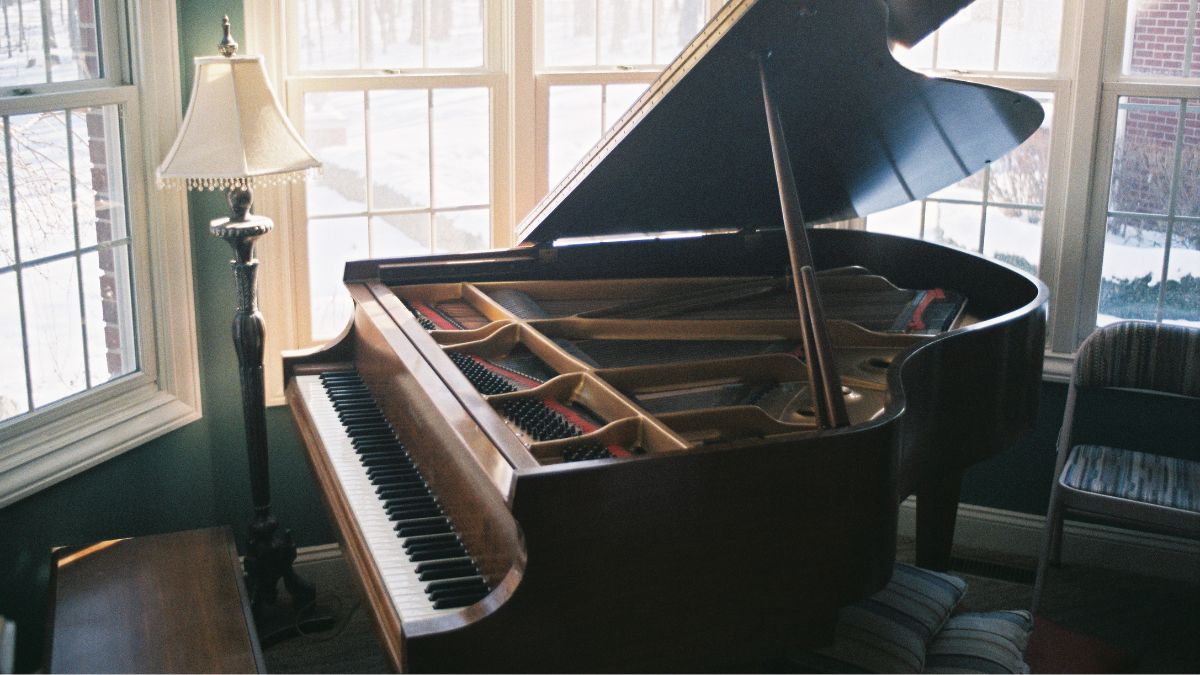

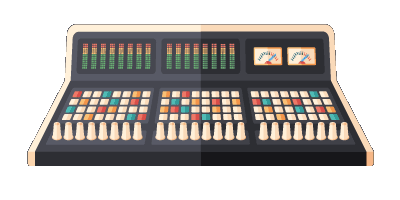
Comments:
May 02, 2023
May 01, 2023
Login to comment on this post